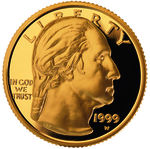Washington quarter
The 200th anniversary of the birth of Washington, the first president of the United States, would occur in 1932, and Congress wished to plan for the event well in advance.President Calvin Coolidge was ex officio chairman of the commission, which included government officials as well as prominent private citizens such as automobile manufacturer Henry Ford.In a lengthy veto message delivered to Congress with the returned bill, Hoover noted his counterfeiting concerns, and stated that the coins were selling badly anyway—large quantities of Oregon Trail Memorial half dollars remained unsold.The obverse of both medal and coin were to be based on the well-known sculpture of Washington (1786) by French sculptor Jean-Antoine Houdon; the artist was not restricted as to the reverse design.By law, coinage designs were approved by the Secretary of the Treasury, at that time Andrew W. Mellon, a noted art collector and connoisseur; it was anticipated he would interpose no objection to the plan.[4] After reviewing the entries, both the Bicentennial Committee and the Commission of Fine Arts (CFA) agreed on designs by Laura Gardin Fraser.[6] On February 9, 1931, New Jersey Representative Randolph Perkins introduced legislation for a Washington quarter, to the dismay of the Bicentennial Committee and Fine Arts Commission.On February 12, Fine Arts Commission Chairman Charles W. Moore wrote to the House Committee, objecting to the change of denomination, and proposing that they mandate that Laura Fraser's design for the medal also appear on the coin.[8] On July 14, 1931, Assistant Mint Director Mary Margaret O'Reilly wrote to Moore, asking the commission's advice on a design competition for the new quarter.Secretary Mellon responded to Moore, stating that as the Treasury had been no party to the earlier design agreement, it was not bound by it, and would not follow it.Secretary Mills informed Moore that the chairman's letter had caused him to request changes from the sculptor, but that he would not override Mellon's decision.[12] Fraser's design was used in 1999 as a commemorative half eagle issued 200 years after Washington's death,[12] and has been recommended as the obverse beginning in 2022.[14] In 1785, the French sculptor Jean-Antoine Houdon was commissioned by the Virginia General Assembly to sculpt a bust of Washington, who had led the nascent United States to victory in the American Revolutionary War.The retired general sat for Houdon at Mount Vernon, the Washington family home in Fairfax County, Virginia between October 6 and 12, 1785.[17] Art historian Cornelius Vermeule said of Flanagan's quarter, "a die designer could do little wrong in having Houdon's Neoclassic image as his prototype ..."[8] Vermeule suggests that the quarter started a trend of similar portrait coins issued by the United States, notably the Jefferson nickel and Franklin half dollar.[19] In early July 1932, newspapers announced that the Washington quarter was being struck and would be issued at the end of the month, once there were sufficient pieces for a nationwide distribution.The original style had a high rim around the reverse design, protecting it from wear so well that 1932 quarters in lower grade generally are about equally worn on either side.[31] Silver prices were rising, and the public responded by hoarding not only the wildly popular new coin, the Kennedy half dollar, but the other denominations, including the non-silver cent and nickel.[37] The Mint adjusted both sides of the coin for the initiation of clad coinage, lowering the relief (the modified reverse design exists on some 1964-dated silver quarters).[45] On June 6, Mint Director Mary Brooks testified before a congressional committee, and responding to concerns that only the two least-popular denominations would be changed, agreed to support the temporary redesign of the quarter as well.[46] On October 18, 1973, President Richard Nixon signed legislation mandating a temporary redesign of the three denominations for all coins issued after July 4, 1975, and struck before January 1, 1977.[37] At a congressional hearing in June 1995, Mint Director Philip N. Diehl and prominent numismatists urged Congress to pass legislation allowing a series of circulating commemorative coins similar to the quarters Canada had recently struck for its provinces.In response, Congress passed the United States Commemorative Coins Act of 1996, which was signed by President Bill Clinton on October 20, 1996.The act allowed the Secretary to determine the position of the required legends, such as "IN GOD WE TRUST" on the coin: To accommodate a large design on the reverse, "UNITED STATES OF AMERICA" and "QUARTER DOLLAR" were moved to the obverse, and the bust of Washington shrunken slightly.In October 2019, the Citizens Coinage Advisory Committee (CCAC) met to consider designs, with the final choice made by Mnuchin.








US dollarsreededLaura Gardin Fraserquarter dollarUnited States MintJohn FlanaganGeorge WashingtonCongresshalf dollarWalking Liberty half dollarStanding Liberty quarterobverseCommission of Fine ArtsTreasury SecretaryAndrew W. MellonOgden L. MillsreverseUnited States Bicentennialthe 50 statesthe nation's other jurisdictionsAmerica the Beautiful Quartersa new commemorative series depicting womenState Quarter ProgramIn God We TrustCalvin CoolidgeHenry FordSecretary of CommerceHerbert Hoovera commemorative coin billOregon Trail Memorial half dollarsWalking LibertyThe DepressionPeace dollarwell-known sculpture of WashingtonJean-Antoine HoudonSecretary of the TreasuryJames Earle FraserBuffalo nickelNew JerseyRandolph PerkinsHouse of RepresentativesMary Margaret O'ReillyAdolph WeinmanMercury dimeWalter Breenhalf eagleHoudonVirginia General AssemblyAmerican Revolutionary WarUnited States Minister to FranceBenjamin FranklinMount VernonFairfax County, VirginiaNelly CustisVirginia State CapitolAbraham LincolnLafayette dollarSesquicentennial half dollarQ. David BowersCornelius VermeuleJefferson nickelFranklin half dollarThe New York TimesPhiladelphiaDenverSan Franciscomint statemint marksproof coinsKennedy half dollarLyndon JohnsonCoinage Act of 1965mint markWest Point MintPhiladelphia MintGeorge H. W. BushUnited States Bicentennial coinageRichard C. WhiteMary BrooksRichard Nixon50 State quartersPhilip N. DiehlquartersBill ClintonRobert RubinseignorageDistrict of Columbia and United States Territories quartersDistrict of ColumbiaSenatePuerto RicoAmerican SamoaVirgin IslandsNorthern Mariana IslandsNational Park Servicenational forestbullion piecesLincoln centsAnthony dollarprivy markcartoucheSteven MnuchinGeorge Washington's crossing of the Delaware RiverUnited States SemiquincentennialAmerican Women quartersWashington quarter mintage figuresCoin WorldVermeule, CorneliusYeoman, R.S.Bressett, KennethA Guide Book of United States CoinsAtlanta, GeorgiaUnited States Bicentennial quarterHalf cent (1⁄2¢)Nova ConstellatioLiberty CapDraped BustClassic HeadBraided HairLarge centpenny (1¢)Fugio (Franklin)Silver centerWreathMatron HeadFlying EagleIndian Head